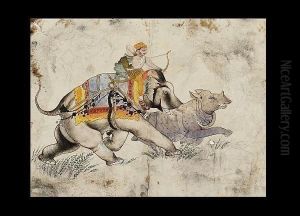Ram Singh I Paintings
Ram Singh I was a noted Indian artist and court painter of the 19th century, particularly known for his contributions to the development of the Kishangarh style of painting. He was born in 1822 into the royal family of Kishangarh, a princely state in the present-day state of Rajasthan, India. As a member of the royal lineage, he had access to a rich tradition of arts and culture, which profoundly influenced his artistic development.
Ram Singh I was the grandson of Sawant Singh, who was famously known as Nagari Das, and was a poet and patron of arts. Under Sawant Singh and his muse, the singer and poetess Bani Thani, the Kishangarh School of painting flourished, becoming known for its distinctive style characterized by elongated features, graceful figures, and a strong emphasis on the themes of Radha and Krishna. Inheriting this artistic legacy, Ram Singh I further enriched the tradition with his own contributions.
During his tenure as the Maharaja of Kishangarh from 1838 to 1885, Ram Singh I was a great patron of the arts, much like his grandfather. He maintained the court studio, patronized local artists, and took an active interest in the development of the Kishangarh style. He was known to have been an accomplished artist himself, mastering the delicate brushwork and refined aesthetic of the Kishangarh tradition. Under his guidance, the Kishangarh school of painting saw a synthesis of local artistic traditions with influences from other schools such as Mughal and Deccani art.
Ram Singh I's reign was marked by a period of cultural renaissance in Kishangarh. The paintings produced during his time depicted not only themes of courtly love but also reflected the daily life, flora, and fauna of the region. His own works often focused on religious and literary themes, especially the tales of Radha and Krishna, which were a staple of Kishangarh's artistic repertoire.
He passed away in 1885, leaving behind a rich cultural legacy. The Kishangarh school of painting continued to thrive for a while after his death, although it eventually declined as the princely states of India were integrated into the modern nation-state. Nevertheless, the unique style of Kishangarh painting that Ram Singh I helped foster remains an important chapter in the history of Indian art, and his contributions are still celebrated by art historians and collectors today.

